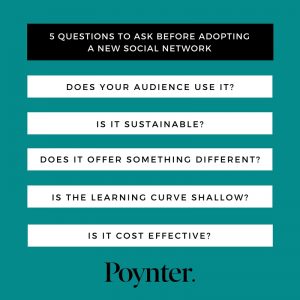A colleague texted me last month with a question that made doubt my early-adopter status.
“Are you on Peach?”
I was not. In fact, I didn’t even know what it was. But a quick Google search told me it was a new messaging app from the man who brought us Vine, the popular video-sharing network that Twitter acquired in 2012.
I quickly downloaded it, registered my standard username and texted her back: “Of course.”
Since then, Peach has been called both “the next best thing” and “completely dead.” A handful of friends still post GIFs every now and then, but the social network’s growth seems to have stalled. Considering the same has happened to Google Plus, Ello, Beme, App.net and countless others over the past few years, it’s not surprising.
What was surprising were the handful of news organizations that adopted Peach early on. Fusion, CNBC, BBC and others posted fairly regular updates for the first month of the app’s existence but have apparently since retreated to the proven pastures of Facebook, Twitter, Instagram and Snapchat. Even though Peach might not dethrone the big networks anytime soon, it was smart of them to adopt it early, even if just to squat on their usernames.
But for smaller news organizations, it can be tough to determine whether a new social network is worth trying. Here are five questions to consider when the next Peach comes around:
Does your audience use it? Fusion bills itself as a “media brand for a young, diverse and inclusive world.” It makes sense for them to jump on new social networks that tend to gain popularity with young audiences first because appealing to youth is part of their mission. News organizations that focus on topics like finance or government minutiae are probably better off targeting interested parties on Facebook.
Audience goals can be aspirational, too. If reaching new, younger audiences is important to your news organization, adopting a social network early might earn you some important brand recognition. When The Wall Street Journal joined Snapchat Discover as a partner earlier this year, they increased their visibility among millennials.
Is it sustainable? Consider the following two questions: Will the new social network be around in a year? And do you have the staff to devote to it?
Doing a little reporting can help with the first question. Beme, a video-sharing app from a popular YouTube filmmaker, slipped from the charts since its launch last summer. But with support from angel investors with proven vision, you can expect it to be around for a while. And while its userbase might not be massive, its most engaged users might be a useful audience for your news organization.
When determining whether you have the staff to devote to a new social network, consider that some of them may already be experts. If your intern is absolutely obsessed with Peach, empower him or her to try it for a month for your organization. It’ll be a good learning experience for everyone involved. Keep in mind that you don’t need a big strategy from the start — that can come later.
Does it offer something different? With a combined total user count of well over a billion, messaging apps WeChat and WhatsApp are two of the most popular apps in the world. Newsrooms are exploring ways to use messaging apps in the newsgathering and publishing process.
But it probably doesn’t make sense to use both. In this case, it’s best to pick one that works better for you (WhatsApp is most popular in Africa and India, while WeChat tops the charts in China).
For other similar apps, it might work to simply double up on content. For instance, the 15-second videos you make for Instagram might also be a good fit on Facebook. Don’t be afraid to capitalize on your work where it makes sense.
Is the learning curve shallow? Some social networks are tougher to break into than others. Between its jargony terms and lack of tools to make sense of the noise, Twitter is famously insidery. Attempts to shed that image have not been well-received. If you don’t have any experts in your newsroom, or if everyone on staff is unwilling to learn, you’re going to have problems with adoption.
Find people who will put in the effort, focus on easier-to-use networks, or seek out training.
Is it cost-effective? Without good photos to share, Instagram is useless. If you need to purchase a suite of expensive gadgets just to start using a social network, it may be outside of your wheelhouse. Your social presence should be a reflection of your newsroom’s strengths and values. If it feels like a stretch to post and interact regularly, consider that it might not be right for you.
Still not sure how to parse the world of emerging social media? Join us on Wednesday at 2 p.m. EST for Periscopes, Peaches and Yaks: What’s Next on Social Media.








